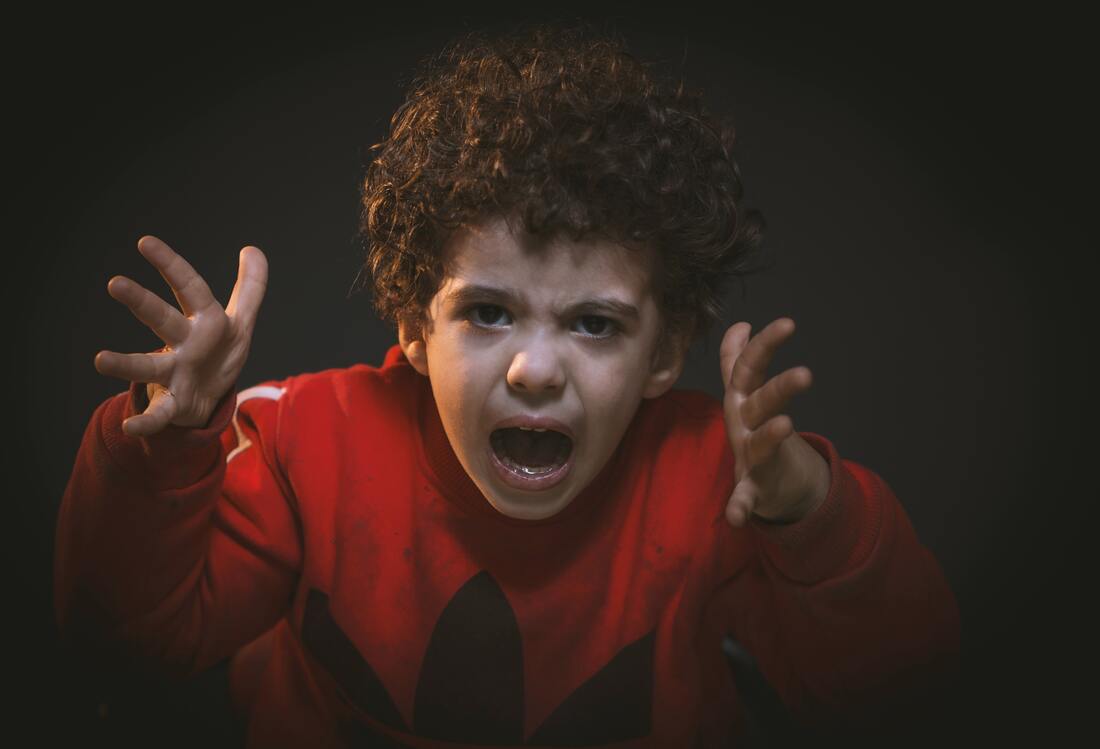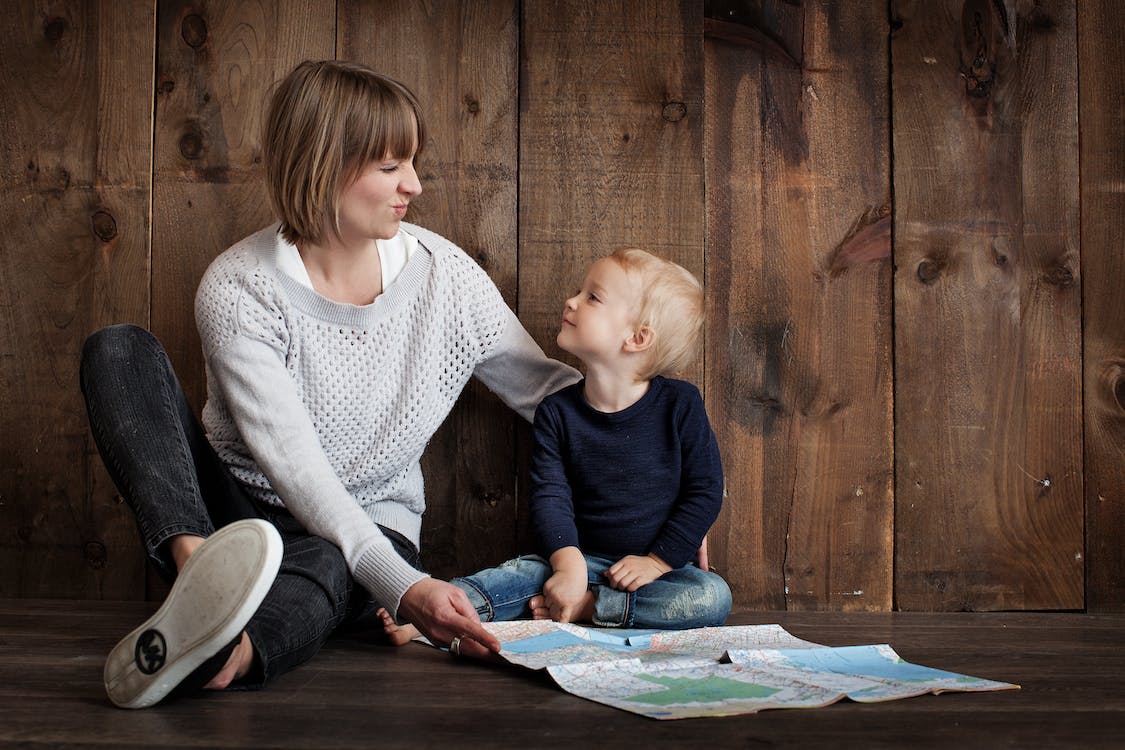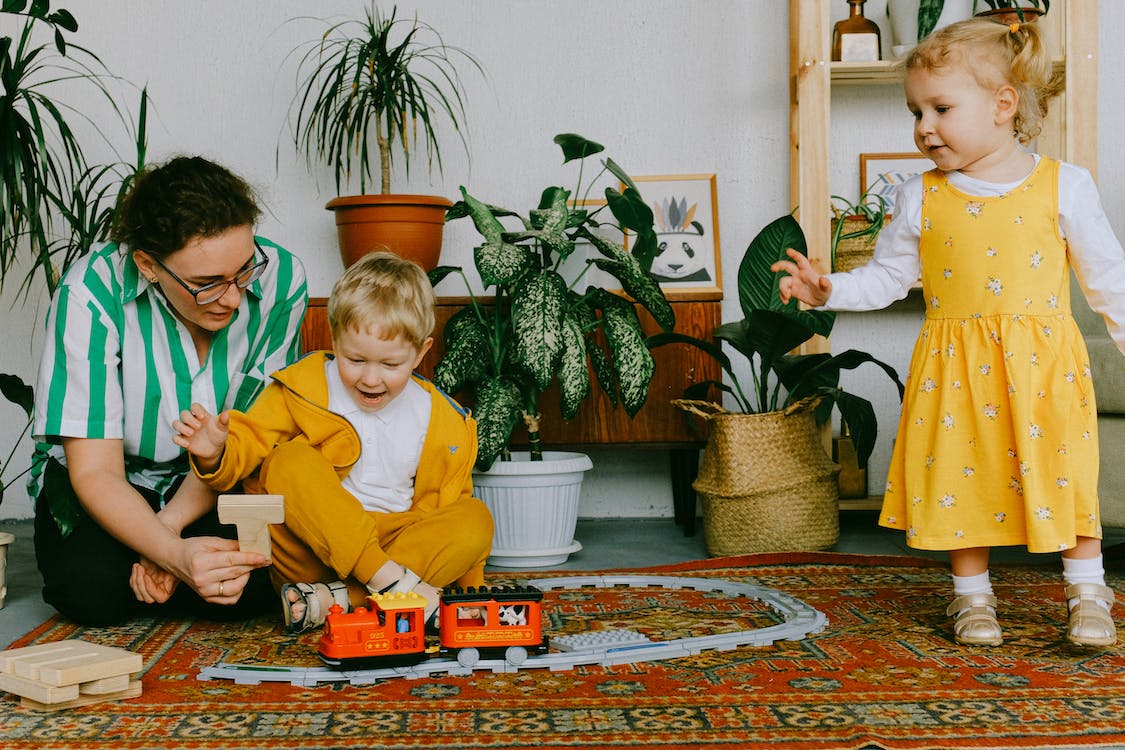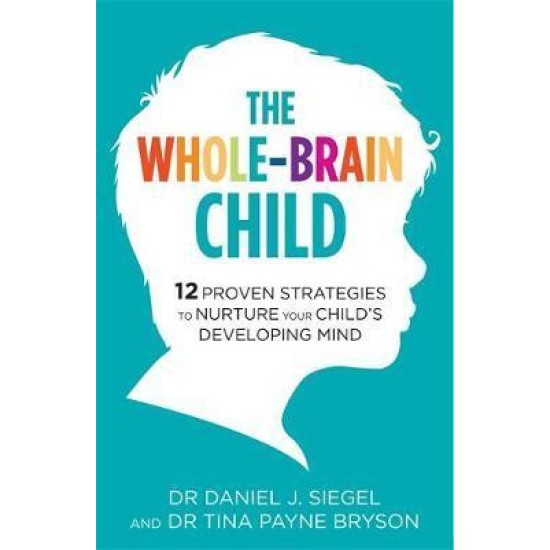|
A life without worry is a dangerous thing. It would mean a lack of concern for consequences of our actions, a reduction in reflective thinking and a reduced drive to get things done by a deadline. It would mean we would step out in front of the busy road, or test if the iron is hot by using our finger. Worry has been a safety mechanism for us throughout the evolutionary process, and has help ensure our survival. The point being, that a little bit of worry is a good thing. The other end of the scale is a debilitating experience when we cannot think of anything but mistakes we have made or have a fear of the future that is enough to make us physically sick and interrupt our lives. So how do we know when to worry about worry? How much is enough? And how to help foster a sense of safety without taking away our children’s ability to experience worry and instead learn to cope with it? If compared to other children you see that your child gets worried more often, and more intensely than others, and things have persisted for some time, then it might be time to get some professional support. Other signs to look out for include irritability, avoidance of things they might have previously enjoyed, physical complaints like a sore tummy, or comments like things being ‘boring’ or ‘stupid’, when they may in fact be difficult and your child is feeling afraid. Not wanting to go to school or see friends can be a red flag for a child experiencing anxiety. As a parent, there are some things you can do at home to help foster a sense of resilience to things that may be worrying and help your child cope with those feelings. Some possible ways include:
The relationship building that you do with your child will ultimately underpin these strategies. Being able to give them the confidence to believe what you say, to confide in you, and to give them the feeling of independence and competence to take on the world. Don’t minimise the positive interactions that you have together in the big jigsaw puzzle of your child’s world. Plant the seeds of the relationship when they are 5, so they know when they are 15, that you are cheering them on. As complex and daunting as aggressive behaviour can appear, the way to respond can be simple and involves answering 3 questions:
1. What emotions am I (as the parent or carer) feeling right now? If we are not emotionally regulated when we respond to a child, there is a high likelihood that this will only perpetuate the situation. The child’s need remains unmet and they now also have additional stress. As the saying goes (and neuroscience attests to), ‘when we are at our angriest… we are at our stupidest’. Speaking of, when children are highly emotionally dysregulated they don’t have access to their pre-frontal cortex which is responsible for problem-solving, reasoning and perspective taking. So, asking them to ‘make a good choice’ at the height of aggressive behaviour probably isn’t going to work. We should try and emulate what we can see a duck in a pond look like; on the surface it is calm and graceful, underneath is a little more frantic but that is hidden from view. 2. How are environmental factors influencing the situation? Many times, behaviours are influenced by those observing it. Removing other children or adults can be the catalyst for de-escalation. Similarly, removing yourself partially or fully as a responder (when safe to do so) can also be what is required for de-escalation to occur. 3. What does my child feel, need or want? Behaviour is almost always a form of communication that expresses a need. Identifying and reflecting back your child’s need or feeling goes halfway to solving the problem. There is a difference between caving into unrealistic demands and simply demonstrating to your child that you can hear and understand their frustration. Children may need up to a few hours to recover and return to a baseline state. This is the time to have that conversation about what they can do to get their needs met next time in a more adaptive way. If you are seeking parenting support or support for your child, please contact the clinic to book an appointment with one of our psychologists. A tantrum is an outburst of intense, emotion-driven behaviour that can be exhibited by young children. They typically start between the ages of 1 and 4, and can last well into later childhood years. A meltdown is ALSO an intense and overwhelming emotional response that can be exhibited by individuals, but they can occur at any age, and are more commonly associated with neurodevelopmental conditions such as autism, sensory processing disorder, ADHD, anxiety, as well as some mental health difficulties, such as PTSD. During both tantrums, and meltdowns, an individual may scream, cry, kick, throw objects, hurt themselves accidentally or on purpose, or withdraw and seem to shut down. Tantrums can occur in response to frustration, anger, or other strong emotions, and can be triggered by a variety of factors, such as hunger, fatigue, overstimulation, or a desire for attention or control. Tantrums are a normal part of child development and can be a way for children to express their emotions when they do not yet have the language skills to do so effectively. Meltdowns can also be triggered by a variety of factors, such as sensory overload, emotional stress, changes in routine, or difficulty with communication or social interaction. In both tantrums and meltdowns, the behaviours can be distressing for both the individual experiencing the difficult emotions, and for those around them. And it’s important to note that something might start as a tantrum, but as the individual becomes increasingly overwhelmed by their emotions and the bodily sensations and stress these bring about, they might move into meltdown. In either instance, we need to understand that the child or individual isn’t behaving this way on purpose and that they feel awful. Nobody likes having these strong and overwhelming emotions, and most of us want to feel calm and happy rather than angry and upset. A calm, compassionate, and curious approach to individuals who are experiencing strong emotions is often the fastest way to both help them back to calm, and understand what happened to them. If you or your child are struggling with tantrums or meltdowns, you might like to have a look at our Director, Jessica Cleary’s evidence-based Calm and Connected Parenting Program to help you understand what’s going on, and to calm the chaos. You can find a link HERE. Helping Teens Through Disappointment: 5 Compassionate Strategies for Uncontrollable Outcomes30/6/2023
by Jessica Cleary, Psychologist Like many parents in Australia I have a devastated teenager in the house after fruitless efforts trying to get Taylor Swift tickets this week. As parents, we strive to support our teenagers through life's ups and downs, including moments of disappointment that are beyond their control. Whether it's missing out on tickets to Tay Tay or facing other circumstances where they have no influence over the outcome, our role as compassionate and loving parents becomes crucial. By providing the right guidance and support, we can help our teenagers navigate disappointment and emerge stronger and more resilient. Here are five tips to assist you in helping your teenager through situations where they lack control, with love and understanding. 1) Practice active empathy: In moments of disappointment, actively empathise with your teenager's feelings and experiences. Put yourself in their shoes and try to understand the depth of their emotions. Let them know that you are there to listen and support them wholeheartedly. By showing genuine empathy, you create a strong bond and provide reassurance that they are not alone in their struggles. 2) Avoid comparisons: Avoid comparing your teenager's disappointment to others' experiences or minimising their feelings. Each person's disappointments are valid and unique to them. Remember that everyone has different expectations and sensitivities, and what might seem insignificant to one person can be deeply disappointing for another. By avoiding comparisons, you create an atmosphere of compassion and respect for their individual emotions. Any sentence that starts with "At least..." is one to be avoided. 3) Encourage self-expression: Once the dust settles a little, encourage your teenager to express their disappointment through creative outlets, such as writing, painting, or playing music. These forms of self-expression can provide a cathartic release for their emotions and allow them to process their disappointment in a constructive way. By embracing their creativity, you empower them to channel their feelings into something meaningful and transformative. 4) Be patient and non-judgmental: It's essential to be patient and non-judgmental when supporting your teenager through disappointment. Avoid offering quick solutions or trying to snap them out of it. It's very uncomfortable for us to see our children distressed so often we can try to shift them out of their 'mood' to ease our own distress. That's not what's needed here. Instead, provide them with the space and time they need to process their emotions and navigate their own path to healing. By demonstrating patience and non-judgment, you foster an environment of trust, emotional safety and unconditional love. 5) Nurture self-compassion: In situations where disappointment arises from circumstances beyond their control, it's crucial to nurture self-compassion within your teenager. Encourage them to be kind to themselves and avoid self-blame or negative self-talk. If you notice any of this type of talk, gently remind them that disappointments are not personal failures and that they are not defined by external outcomes. Teach them to practice self-care and self-compassion by engaging in activities that promote their well-being, such as spending time with loved ones, pursuing hobbies, or engaging in mindfulness practices. It’s so hard to bear witness to our children’s experience of disappointment. Remember that your support and understanding are invaluable in helping your teenager face these challenges and emerge stronger. These practices can help your teenager embrace the uncertainties of life, navigate disappointments, and forge a path towards a fulfilling and resilient future with a compassionate heart.
Kara Vermaak. Provisional Psychologist As a parent, it's understandable that you want to be the best caregiver you can be for your child, but often parents find themselves busy, tired, overwhelmed and unable to connect with their children in the way they’d love to. It's important to remember that it’s not about being a perfect parent, but trying to be a more mindful parent. Being a mindful parent is about being present and compassionate with yourself and your child, and this takes practice. Practicing mindfulness as a parent can be a powerful tool for enriching your relationship with your child and fostering a deeper sense of connection and understanding. By being more present with your child and practicing non-judgmental awareness, you can create a safe and supportive space for them to explore and grow. Here are 3 steps to being a more mindful parent: 1. Practice self-care As a parent, it can be easy to get caught up in the demands of daily life and neglect your own wellbeing. However, taking care of yourself is essential for being a mindful parent. Make time for activities that nourish your mind and body, such as exercise, eating healthy, or spending time in nature. By prioritizing your own well-being, you'll be better equipped to be present with your children. 2. Practice active listening Mindful parenting involves being fully present and engaged with your children. One way to do this is to practice active listening. This means giving your full attention to your child when they're speaking, without interrupting or rushing them. Listen to their words, tone, and body language, and respond with empathy and understanding. By truly listening to your child, you can deepen your connection with them and help them feel seen and heard. 3. Practice non-judgmental awareness Mindful parenting involves being aware of your own thoughts and emotions, as well as those of your child. Rather than reacting to challenging situations, try to approach them with non-judgmental awareness. This means observing your own thoughts and emotions without judgment or criticism, and responding with kindness and compassion. By modelling this kind of awareness and acceptance for your child, you can help them develop a healthy relationship with their own thoughts and emotions. Remember to be gentle with yourself as you cultivate your mindfulness practice. It's okay if you have moments of distraction or judgment - that's all part of the learning process. The important thing is to approach each moment with curiosity and compassion, and to continue practicing even when it feels a little challenging. For more support, please reach out and book an appointment with one of our friendly psychologists
Abby Elder. Provisional Psychologist Picture this...
An eruption of screaming and fighting pierces your ears. Again. Your eight year old son rushes into the lounge room sobbing and throws himself on the couch next to you. Another fight with his older sister over who gets to choose what game to play together. ‘You are supposed to be having fun and building lifelong memories to be treasured forever!’ You think to yourself. When did having fun become so hard? If your child sometimes appears to be made of glass, try these 9 ways to build resilience, or the ability to recover from the inevitable disappointments and challenges of life. 1.Growth mindset Encourage a practice of gratitude and excitement by asking your child to identify one thing they are looking forward to the next day. 2. Define resilience in age appropriate ways Look for examples in nature like a tree that has continued to grow despite a concrete barrier. Or name some models of a can do attitude in literature or film. 3. Practise the calm How do you feel when you are told to just calm down? Most adults know the bubbling rage that this phrase can instill yet we continue to use this command when a child is overwhelmed. Instead try practicing the calm with your child every day, like taking a vitamin supplement. This can be a three minute body scan that encourages your child to be more aware of body sensations that are signals they need help. Or try green grounding, which encourages a short connection to nature. Think setting a five minute timer on your phone and going cloud gazing. The key to practicing the calm is scheduling it every day at a time when it is achievable. 4. Check your own reactions and expectations Emotions are catching. Children can perceive when we have unrealistic expectations that we are placing on them. Such as, my child should be invited to every birthday party thrown by every classmate. Or, I am a terrible parent because my child is struggling to comprehend long division. Try practising some short, self compassion meditations that will build your own resilience. 5. Encourage problem solving, don’t solve the problem Resiliency is not a force field that repels life’s problems. It’s the confidence that no matter what problem we are faced with there are solutions. Problem solving just like any skill needs to be learned. Parents often want to swoop in and solve their child’s problems, however this is taking away the opportunity from your child to learn how to solve their own problems. 6. Skill building missions Plan for ways your child can prove to herself she is a problem solver. Let her pay for the produce next time you duck into the shops. Bite your tongue when your five year old picks an outfit that slightly clashes, at least they are dressed! Encourage your 11 year old to create a menu of family dinners. 7. Call out your own fragile behaviour, but don’t shame it Name when you are feeling a bit fragile, and role model problem solving through the uncomfortable feelings to your child. 8. Acknowledge the good when it happens We are good at identifying the tough times but we often do not pause and say how great things are going. By acknowledging the good we remind our children that nothing is permanent, the bad times come, and then so do the good times. 9. Encourage accountability Resiliency is about doing what we can with what we have. Encourage your child to name what is in their control the next time they are having a tough time. This will make the path to solutions more clear. For support for you or your child/ren, learn more about our online parenting program It's completely understandable to feel frustrated and overwhelmed when your child is behaving in ways that are the opposite of what you would like, despite your best efforts. Remember that as a parent, it's important to approach these situations with warmth, understanding, and a willingness to learn and grow. It can be helpful to take a step back and re-evaluate your expectations for your child's behaviour. Remember that all children make mistakes and may exhibit challenging behaviours from time to time. Sometimes as parents we our expectations of our children can fall outside of their abilities - by setting developmentally appropriate expectations, you can help your child feel more confident and supported. When your child is behaving in challenging ways, it's important to remain calm and respond in a consistent manner. Reacting impulsively or losing your temper can escalate the situation and make it more difficult to address the behaviour. Instead, try to stay calm and firm in your response, and be consistent in your expectations and consequences. Dr Daniel Siegel, a renowned psychiatrist and author who specialises in child development and neuroscience, has popularised the phrase "connection before correction." This means that before we try to correct or discipline our children, we need to focus on building a strong connection with them. As parents, we want our children to listen to us, respect our authority, and follow rules. However, in order for children to feel willing to listen to us, they need to feel a strong connection with us first. Connection refers to the quality of the relationship between the parent and the child. This includes trust, understanding, empathy, and communication. We often make the mistake of FIRST correcting a child’s behaviour (by telling them off, punishing them, or trying to immediately make them cease their behaviour), and THEN later try to understand what happened to cause them to behave this way. This makes sense to our adult brains, but is unfortunately in the wrong order for children to be able to make sense of. When we instead prioritise connection before we provide corrective responses, we are showing our children that we care about them as individuals, that we want to understand them and what’s upsetting them, causing them to experience big emotions and behaviours, and that we are committed to building a strong and positive relationship with them. By doing this, we create an environment where our children feel safe and supported, which can help them regulate their emotions and behaviour. To put it simply, we need to focus on understanding our children's perspectives, actively listening to them, and showing empathy and compassion towards them. This approach is not only more effective in helping children learn and grow, but also nurtures them to develop into happy, healthy, and resilient individuals. Remember that parenting is a journey, and it's okay to make mistakes and learn from them. By approaching these situations with warmth, understanding, and a willingness to learn and grow, you can help your child develop positive habits and behaviours over time. If you're feeling overwhelmed or unsure of how to address your child's behaviour, consider seeking support from Jessica Cleary’s Calm and Connected Parenting online course, or book a consultation with one of our talented and passionate clinicians. We can provide guidance and support in developing effective strategies for addressing challenging behaviours and strengthening your relationship with your child. Just like an iceberg, when it comes to behaviour, there's so much more going on beneath the surface.
If we only pay attention to what we see, then we're not considering the full picture. You can't deeply understand an individual action without exploring at least some of those things that are rumbling below the surface. In fact, what goes on underneath is what gives rise to the behaviour that you see. Important motivators of the behaviour of young children include their needs and their feelings. What we don't see that influences behaviour includes things like a child's individual temperament, their emotions at the time, different sensory needs such as lighting and sound sensitivities, developmental capacity and limits, past experience that they bring into the moment, thoughts, internal sensations, executive functioning challenges that can affect planning, impulsivity, memory, physiological needs. All of these things we don’t see, are going to give rise to what we are actually seeing above the surface. When you start to feel challenged or frustrated by your child's behaviours, take some time to consider things on a deeper level. What could be going on below the surface? Our online Parenting Program explores child behaviour at great length with many strategies for you to use to navigate challenging parenting situations Jessica Cleary, Psychologist How did your kids go at the beginning of the new school year? If you do kinder or school drop-off you will have noticed some kids take the new challenge in their stride, whereas others have a much harder time with the transition and separation from their parents.
Maybe you found yourself with a little one who was crying and clinging and begging you not to leave. I feel for you if this was the case – it’s so hard! Or maybe your child complained of tummy-aches or headaches before leaving home. This is a common symptom of anxiety. It’s fairly common for some kids to have troubles adjusting to school. Although there is no magic solution when supporting your child through separation anxiety, here are some ideas for you: Find a friend It helps immensely when kids have a friend at school. Ask the teacher who your child seems to play with the most and introduce yourself to the parent at either drop off or pick up. Arrange a play date over at your house or a park to help nurture that relationship. Talk about it ahead of time If you know that tomorrow is likely to be another morning of tears and clingy behaviour then talk about it today when you are both feeling calm and relaxed. When children fear something, they need the opportunity to express and feel their feelings. Some of their worries or concerns may seem small or insignificant to us, but for them they are very real and should be believed and respected. It is important to acknowledge that the feeling of worry is very real for your child. After you've validated their feelings, then gently move to problem solving. Remind them of the fun parts of the day like playing with a friend or lunchtime (if this is fun for them). Remind them that after a little bit of upset they were able to enjoy the school day and they got to do new and exciting things. Let them know that you will ALWAYS come back at the end of the day to pick them up (or make sure they know the plan if there is after-school care). Team up with the teacher Work in partnership with the teacher. Experienced teachers have been through this before so are likely to have a few good ideas. If the separation anxiety doesn’t ease after a few days the teacher may be able to give your child a special job to do immediately upon getting to school. This will serve as a transition activity and is something for him to look forward to. Get to school early so the teacher can personally greet your child and take him to the activity. Don’t focus on the separation On the way to school talk about the first thing your child will do once they get in the classroom. It shifts the focus from the separation to the enjoyable activity. This helps them mentally prepare before they are physically at school. They start to visualise the inside of the classroom and can start to get used to the idea of being there. Something like this: “When you go to the reading corner, what book are you going to read first?” or “Which colouring in page will you choose when you get there – the train or the castle?”. Or if you have an arrangement with the teacher (see previous tip) you can talk about this with enthusiasm. Don’t talk about ‘school’ At home in the morning, don’t talk about ‘school’ too much. Talk about ‘reading time’ and ‘drawing’ and 'play time’. Talk about that first activity that he will be doing with the teacher (if you have one planned). The word ‘school’ may currently have a negative, anxiety provoking association for your child so minimise using that work might help if this is the case. Instead talk about the activities they will be doing at school that you know they enjoy. This makes the idea of school more concrete and less abstract. Transitional objects A special note from you kept in their pocket, or matching love hearts drawn on their hand your hand can help your child feel connected to you during time apart. Other issues Sometimes separation anxiety occurs in the context of more generalised anxiety or trauma. Maybe there is a real problem at school that is causing distress. Listen carefully to your child and do a little detective work if you sense there is more to the story. Could it be that they don't know how to ask to go to the toilet? Or they are being bullied? Do they find it hard navigating the school grounds at recess? Listen carefully and get more information from the teacher to help you work out what the underlying problem may be. When to seek professional support Often patience and using the above tips can ease separation anxiety. However, there are times when it is necessary to reach out for additional support. You may need further help if:
Finally Remember, your child isn’t trying to manipulate you in order to stay home. The feelings are real for your child and quite distressing. Although you may not always be able to prevent the separation anxiety, you can always empathise with your child and connect with them with cuddles and snuggles at the end of the day. You wouldn’t be the first parent to cry on your way to work after holding it together at school drop-off. This experience is so very stressful for parents. Look after yourself to help manage your own stress. Sleep (if you're at a a stage of parenting where that's possible!) and eat well and talk to a trusted friend who will listen and support you. Taking care of yourself and allowing yourself your own emotional release will help keep you centred and more emotionally available for your child. Alyce Galea, Psychologist It is essential that our young people learn how to manage the intensity of their emotions, and work through their emotions in a healthy and helpful way.
It is not something that that we are inherently born knowing how to do, so it is important that parents and/or caregivers help facilitate a safe space for children to learn emotion regulation. Here are 5 important tips to help you help your children: 1. Be warm, accepting and responsive to your child’s emotional needs
3. Accept, support and show empathy to validate their feelings
4. Be patient
5. Try not to ignore, dismiss, discourage, punish or react negatively to emotions, especially negative emotion
By being in touch with your own emotions and being mindful of how you manage them, you can be a role model for your children and help them feel safe to express their own emotions in a healthy and helpful way. For more parenting support or for support for your child, please contact the clinic to book an appointment. Jessica Cleary. Director & Psychologist Sometimes it is challenging getting teens the psychological help they need. Here are some tips to help you...
By Jessica Cleary, Director & Psychologist
"Your normal may be their magic."
It's all about perspective mamas! This video is sure to pull at your heart strings as you watch vlogger Esther Anderson's moving piece of her day from the perspective of both herself and then her young daughter.
After watching, you can't help but reflect on the way you sum up your own days.
Do you hold on to the magical moments and celebrate them? Or do the frustrations leave a more lasting impression? Let this be today's challenge: Notice and hold on to the magic. Breathe in the giggles and the sillyness, the cuddles and the kisses. Breathe out the tantrums and tears, the defiance and backchat. See if it makes a difference on the way you feel. There's a good chance it will!
In this post, we explore how to help bring your focus back to the positive aspects of your life and how to realistically incorporate self care into your busy routine.
One way is to take regular time each day to appreciate the positive things that are happening. Write them down and reflect on them when you need the reminder. When we think of self-care, too often we think of bubble baths and date nights. While both of those things are enjoyable and relaxing, it does not have to be your visual when it comes to self-care. Saying “no” to additional demands is self-care, as is going for a walk around the block for a quiet walk. Eating a healthy meal, or an act of kindness towards another person can also be a form of self-care. Trying something new or engaging in a hobby can also be self-care. Often, we find ourselves saying that we do not have enough time to do some of these things, and our self-care can be one of the first things to drop when we experience stress. However, it is important to remember that taking care of yourself is not a selfish act, it is helping you be the best version of yourself in order to best care for your children. Having a consistent time in the day scheduled for self-care can increase the chance that it happens and can be for just 3 minutes per day to start with. Being energised and refreshed helps us parents with patience and compassion and helps us model to our children that it is ok to take time for ourselves, ask for help and deal with our stresses in healthy ways. So, when you feel the stress and negativity creeping in, remember that it is ok to stop and ask for help. Giving 100% of yourself does not have to mean working until you fall apart. Having someone to talk things through can help give you some perspective, and often just getting things out of your head can be helpful. It may be helpful for you to consider services like - Parentline (1300 30 1300) - lifeline (13 11 14) - Your GP or even the ear of a friend. If you are in need of further support, please contact the clinic to book an appointment with one of our friendly psychologists. What is behaviour? Behaviour is the way someone acts or conducts themself, especially toward or around others. When discussing children’s behaviours, we often find ourselves using the terms positive and negative behaviour or appropriate and inappropriate behaviour. Difficult Behaviours and why we act so quickly around them Children may at times display negative or inappropriate behaviour. As parents and adults, our first thought is to react to this behaviour straight away to try to cease it, because it is not considered appropriate in the current situation. The behaviour may be having negative effects on other people or their thoughts about the child or about us! Why do behaviours occur? Behaviour occurs for many reasons. The reasons we behave are called functions. There is often a function of every behaviour we see or do. The function is the Why. A person may be trying to gain someone’s attention, seek control of a situation or express their thoughts or feelings, none if which are wrong. The difficulty some children may encounter is in understanding how to use positive and appropriate behaviours instead. Noticing why behaviour is occurring is extremely important. We need to know why behaviour is happening and what a child wants, so that we can assist them to gain this in an appropriate way. When children have not independently clued onto how to behave in a positive manner, to get what they are after, they may continue to use negative behaviour because this is what they are familiar with… and maybe it has been working for them so far! Proactive and Reactive Methods Reacting to behaviour to try to stop or reduce behaviour after it has occurred is surprisingly called… a reactive strategy. Reactive strategies can include giving verbal feedback to a child or a fair and logical consequence occurring. Teaching a child a skill (like how to gain something in an appropriate way) before the child is in a situation is called using a proactive method. Using a proactive strategy gives a child the appropriate behaviour to use, and gives them the best chance to demonstrate a positive behaviour. They then have a better chance of what they want, which will encourage them to use the desired behaviour again. Do we need a more systematic game plan? If you find that a negative behavour is occurring again and again, and you can’t seem to redirect the behaviour to something more appropriate, these tips may help:
- Do they want someone’s attention? - Do they want to be in the ‘drivers seat’ of the situation? - Are they trying to communicate a thought or a feeling? - Are they trying to release frustration? - Are they trying to regulate themselves or self-soothe? - Are they trying to avoid something?
Knowing how to respond to behaviour, to encourage positive skills, and discourage negative behaviour is a tricky task. Every child is extremely different and will be encouraged and discouraged with varying methods of adult responses. If you have noticed difficult behaviours and would like some assistance to increase your child’s skills and to encourage positive behaviours, please contact us - we are here to help. Dr Dan Siegel is a neuropsychiatrist and pioneer in understanding the relationships between the developing brain, emotional experiences and attachment.
Dr Siegel's resources and videos on “Connection before Correction” and the “Hand model of the brain” are extremely valuable video resources explaining complex neuroscience terms in easily understandable ways, and in ways that are easily applicable to parents in supporting their children when dysregulated. Why do I love it? I love recommending Dan Siegel’s approach to emotional literacy to all parents who seek help in how to better support their children who experience dysregulation. Dan Siegal’s books and resources help parents gain a better understanding of helpful ways to respond to a dysregulated child. He stresses the importance of empathy and feeling more connected with their child through teaching effective co-regulation skills. What is a key takeaway? Connection before correction may seem like just 3 words, but it encapsulates a whole lot more than just what those 3 words mean. By helping parents understand the importance of increased connection and understanding of their children’s needs/barriers, we can also help them explore and develop their emotional literacy. This then helps create more meaningful and positive relationships between parents and children, and more open communication and emotional expression between children and parents. Why my clients should read it? All parents can benefit from increasing their understanding of their emotional experiences, common triggers of these, and also what can be done to help manage certain emotions. You can purchase "The Whole Brain Child" here: https://www.bookdepository.com/Whole-Brain-Child-Daniel-J-Siegel/9780553386691 Learn more about Dr Dan Siegel's work here: https://drdansiegel.com/ Alyce Galea. Psychologist Talking with a highly emotional teenager can be tough! When our emotions are heightened, our ability to access and use the thinking part of our brain can become really difficult, and it can be almost impossible for us to use rational thought.
Here are some tips on how best to communicate with your teen when they are in an emotional state: 1. Remain calm and check in with yourself. There is very little benefit to trying to communicate with your teen when they are in a heightened state, and the same goes for when you are experiencing big emotions.The most helpful thing you can do in this situation is to check in with yourself and try to remain calm as best you can. If your teens can sense your calm, they are more likely to calm themselves and be in a better position to effectively communicate with you. There is a scientific principle called neuroception that helps us understand this - when we are in the presence of a calm person, our brain picks up on those calming signals and our brain understands that we are safe. Being safe leads to feelings of calm. 2. Be present. Although your teen may not want to have a conversation with you, it’s important that they know that you are there for them and available to talk when they are ready. That gesture alone might be enough for them to trust that you are open and willing to hear them out. 3. Take a strengths based, non judgemental approach. Although you might not agree with how your teens behave, or how they should feel in a response to a certain situation, it’s helpful to provide a safe, non judgemental space for them to vent and talk it out. 4. Offer to listen and comfort, rather than “fix” things. Your job is not to fix things, per se, but to coach your children, offer the support they need and encourage them to practice skills of emotion regulation and problem solving, until they find what works for them. The way we problem solve and deal with our emotions, may not be particularly helpful for our teens. It’s important to remember that when we come to the solution for a problem ourselves, often with support from another person, we’re more likely to be able to make sense of the problem solutions and put them into practice - rather than when somebody imposes their solutions on us. 5. Expect rejection and avoid feeling disheartened. Adjust your expectations about how the conversations might go, so that you can avoid feeling disheartened or taking things personally. Your teen might test you a little until they can trust that you genuinely care and want to help them. It may take some time and persistence to reconnect with your teen, don’t be put off. If you’re willing to make the changes to better communicate with them, they will come through. I hope this has given you some helpful tips to be able to alter the way you communicate with your teens to build a stronger connection with them. Contact the clinic if you are in need of parenting support or support for your teen  If you have two or more children OR have a sibling yourself you probably know a thing or two about sibling rivalry. Even though hearing these squabbles can totally push our buttons, we need to stop ourselves from stepping in too quickly as it can rob our kids the opportunity to practice the important skills of problem solving, negotiation and compromise. Learn more in our webinar that takes a deep dive into Sibling Rivalry Dad’s mental health matters too. Dad’s have a unique and great impact on their child’s social and emotional development. Listed below are five starting places for Dad’s to explore their role as a parent and caring for their own mental health. Dad’s are an important member of the parenting team. The Centre for Perinatal Excellence (COPE) have developed a number of resources with valuable and down to earth advice for fathers and partners on adjusting to life with a baby. COPE explores topics such as what to expect during pregnancy, birth, and life with a baby. Information is included on the signs of anxiety and depression to look out for in men. There are also tips for maintaining positive wellbeing during this transitional time. Dad’s can understand what skills and difficulties are age-appropriate. The Raising Children Network and KidsMatter websites provide information on what to expect from children at different ages and when to seek advice regarding a child’s development. Through learning about typical development, dad’s can feel more confident about understanding the many changes that happen as children grow up and how to support their relationship with their child. Dad’s have strengths that make them great parents. Take a moment to reflect on what qualities are important to you as a parent. Consider how day to day interactions with your child may or may not display these qualities. It can be easy to miss the remarkable moments of strength, kindness and wisdom that all parents share with their family. Dad’s can seek support for parenting skills. Participating in a group program can be a great opportunity to connect with other people who may be experiencing similar challenges to your family. It can also offer a chance to hear different strategies and ideas that might work in your family. Evidence based programs include Tuning into Kids, Triple P, and Health Dads Healthy Kids. Sometime attending a program isn’t feasible. Luckily, there are online options such as ParentWorks that can be done at home and at your own pace. Reach out to employers for organisational support. Balancing multiple priorities such as family, friends, work, and leisure activities can be a stretch. If you are feeling stressed or down you may be able to access an employer assistance program (EAP) giving you access to short-term counselling. Alternatively, it may be possible to have a conversation with an employer around family friendly work arrangements. Last week we wrote about the 6 specific areas of life/work that have been identified as contributing to stress and burnout. This week, I'm exploring how to help bring your focus back to the positive aspects of your life. One way is to take regular time each day to appreciate the positive things that are happening. Write them down and reflect on them when you need the reminder. When we think of self-care, too often we think of bubble baths and date nights. While both of those things are enjoyable and relaxing, it does not have to be your visual when it comes to self-care. Saying “no” to additional demands is self-care, as is going for a walk around the block for a quiet walk. Eating a healthy meal, or an act of kindness towards another person can also be a form of self-care. Trying something new or engaging in a hobby can also be self-care. Often, we find ourselves saying that we do not have enough time to do some of these things, and our self-care can be one of the first things to drop when we experience stress. However, it is important to remember that taking care of yourself is not a selfish act, it is helping you be the best version of yourself in order to best care for your children. Having a consistent time in the day scheduled for self-care can increase the chance that it happens and can be for just 3 minutes per day to start with. Being energised and refreshed helps us parents with patience and compassion and helps us model to our children that it is ok to take time for ourselves, ask for help and deal with our stresses in healthy ways. So, when you feel the stress and negativity creeping in, remember that it is ok to stop and ask for help. Giving 100% of yourself does not have to mean working until you fall apart. Having someone to talk things through can help give you some perspective, and often just getting things out of your head can be helpful. It may be helpful for you to consider services like Parentline (1300 30 1300), lifeline (13 11 14), your GP or even the ear of a friend. Megan Mellington, Psychologist As a parent, we will undoubtedly encounter moments of frustration towards our children. It could be awoken by the simplest of circumstances, such as needing to repeat ourselves like a broken record, intervening with siblings squabbling over a toy, or because we are stressed by other things and our tolerance for managing challenging behaviours is limited. However, as many of you might already have experienced, when we respond with anger this often only escalates the situation with our child, and they too may then respond in a similar manner. While many of us have regrettably resorted to shouting, questioning or punishments out of anger, what is important to remember, first of all, is that you are human. Anger is a normal part of the spectrum of human emotions. Anger isn’t bad, it reminds us that we are passionate about something like perhaps wishing to raise respectful, emotionally regulated and empathic little humans. So when less than desirable behaviours are observed in our children, we want to help them develop ways to self-manage, through teaching and implementing boundaries. Sometimes though, when we have been teaching and redirecting our children all day, our waning tolerance for their tantrums or perceived “defiance” can move us to anger. This article aims to outline some tips about how to tame our own “angries” so that you can engage with your children in a mindful and empathic way. I've previously shared Dr Dan Siegal's video explanation of what happens in the brain when we get angry and how the thinking part gets shut down. So how do we get our “thinking brain” back online so that we can respond in a more helpful way for our children? The following are several brief tips I often use in parent consultations to support this process:
Repair involves:
We can’t always be an emotionally regulated parent, and we shouldn’t expect this of ourselves. Even if we do take our anger out on our children, there are many things we can do to minimise the likelihood of this happening in future. If we can tame our “angries” by recognising our emotional state, taking a pause before responding, and regulating ourselves before attempting to regulate our child, we are modelling adaptive and healthy ways of managing anger.
|
Categories
All
|
Hopscotch & HarmonyAt Hopscotch & Harmony Psychology, you can expect compassionate care and evidence-based guidance on your journey to wellness.
With clinics in Werribee and Belmont, as well as providing online counselling to clients who live throughout Australia, our dedicated team of psychologists and dietitians are committed to providing support to children, teenagers and adults. With a focus on understanding your unique needs, we offer tailored solutions to foster growth and resilience. Trust in our experience and dedication as we work together towards your well-being. Welcome to a place where healing begins and possibilities abound. |
Our services |
Contact usHopscotch & Harmony
Child, Teen and Adult Psychology Our Locations:
WERRIBEE: 1/167-179 Shaws Rd
BELMONT: 92 Roslyn Rd AUSTRALIA-WIDE: Online counselling |
Hopscotch and Harmony respectfully recognise the Aboriginal and Torres Strait Islander people as the first Peoples of the continent now called Australia.
We acknowledge the Bunurong and Wadawurrung people of the Kulin Nation, the traditional owners of the land on which we work, and pay our respects to their Elders, past, present and emerging.
© 2024 Hopscotch and Harmony Pty Ltd


























 RSS Feed
RSS Feed
